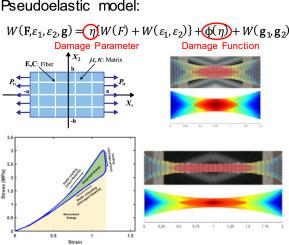当前位置:
X-MOL 学术
›
Int. J. Eng. Sci.
›
论文详情
Our official English website, www.x-mol.net, welcomes your
feedback! (Note: you will need to create a separate account there.)
A pseudoelastic response of hyperelastic composites reinforced with nonlinear elastic fibrous materials: Continuum modeling and analysis
International Journal of Engineering Science ( IF 5.7 ) Pub Date : 2024-05-17 , DOI: 10.1016/j.ijengsci.2024.104092 Mahdi Zeidi , Suprabha Islam , Chul B. Park , Chun Il Kim
International Journal of Engineering Science ( IF 5.7 ) Pub Date : 2024-05-17 , DOI: 10.1016/j.ijengsci.2024.104092 Mahdi Zeidi , Suprabha Islam , Chul B. Park , Chun Il Kim

|
The present study aims to develop a continuum-based model to predict the pseudoelastic behavior of biological composites subjected to finite plane elastostatics. The proposed model incorporates a hyperelastic matrix material reinforced with nonlinear fibers, addressing challenges such as irreversible softening responses, large deformations, and nonlinear stress–strain responses. The kinematics of reinforcing fibers are formulated via the first and second gradient of continuum deformations and, more importantly, damage function and damage variables of Ogden–Roxburgh and Weibull type are integrated into the model to assimilate the various aspects of damage mechanisms present in soft tissues. Adopting the framework of variational principles and a virtual work statement, the Euler equation and admissible boundary conditions are obtained. The proposed model successfully predicts the Mullins effect observed in the human aorta and the Manduca muscle. Experimental validation with elastomeric composites demonstrates its utility to replicate softening and fiber damage phenomena, including deformation profiles. Further, the proposed molecular dynamics scheme offers an enhanced understanding of polymer chain entanglement processes, thereby facilitating the quantification of permanent damage in elastomeric composites. The obtained results may provide valuable insight toward understanding and modeling the mechanical behavior of soft biological tissues with practical implications for the design and analysis of biofabricated composites aimed at mimicking biological tissues.
中文翻译:

非线性弹性纤维材料增强的超弹性复合材料的伪弹性响应:连续体建模和分析
本研究旨在开发一种基于连续体的模型来预测有限平面弹性静力学下生物复合材料的伪弹性行为。所提出的模型采用了非线性纤维增强的超弹性基体材料,解决了不可逆软化响应、大变形和非线性应力应变响应等挑战。增强纤维的运动学通过连续体变形的第一和第二梯度来制定,更重要的是,Ogden-Roxburgh 和 Weibull 类型的损伤函数和损伤变量被集成到模型中,以同化软组织中存在的损伤机制的各个方面。采用变分原理和虚功陈述的框架,得到了欧拉方程和容许边界条件。所提出的模型成功预测了在人类主动脉和曼杜卡肌肉中观察到的马林斯效应。弹性复合材料的实验验证证明了其在复制软化和纤维损伤现象(包括变形轮廓)方面的实用性。此外,所提出的分子动力学方案增强了对聚合物链缠结过程的理解,从而有助于弹性复合材料中永久损伤的量化。所获得的结果可以为理解和建模软生物组织的机械行为提供有价值的见解,对旨在模拟生物组织的生物制造复合材料的设计和分析具有实际意义。
更新日期:2024-05-17
中文翻译:

非线性弹性纤维材料增强的超弹性复合材料的伪弹性响应:连续体建模和分析
本研究旨在开发一种基于连续体的模型来预测有限平面弹性静力学下生物复合材料的伪弹性行为。所提出的模型采用了非线性纤维增强的超弹性基体材料,解决了不可逆软化响应、大变形和非线性应力应变响应等挑战。增强纤维的运动学通过连续体变形的第一和第二梯度来制定,更重要的是,Ogden-Roxburgh 和 Weibull 类型的损伤函数和损伤变量被集成到模型中,以同化软组织中存在的损伤机制的各个方面。采用变分原理和虚功陈述的框架,得到了欧拉方程和容许边界条件。所提出的模型成功预测了在人类主动脉和曼杜卡肌肉中观察到的马林斯效应。弹性复合材料的实验验证证明了其在复制软化和纤维损伤现象(包括变形轮廓)方面的实用性。此外,所提出的分子动力学方案增强了对聚合物链缠结过程的理解,从而有助于弹性复合材料中永久损伤的量化。所获得的结果可以为理解和建模软生物组织的机械行为提供有价值的见解,对旨在模拟生物组织的生物制造复合材料的设计和分析具有实际意义。

































 京公网安备 11010802027423号
京公网安备 11010802027423号